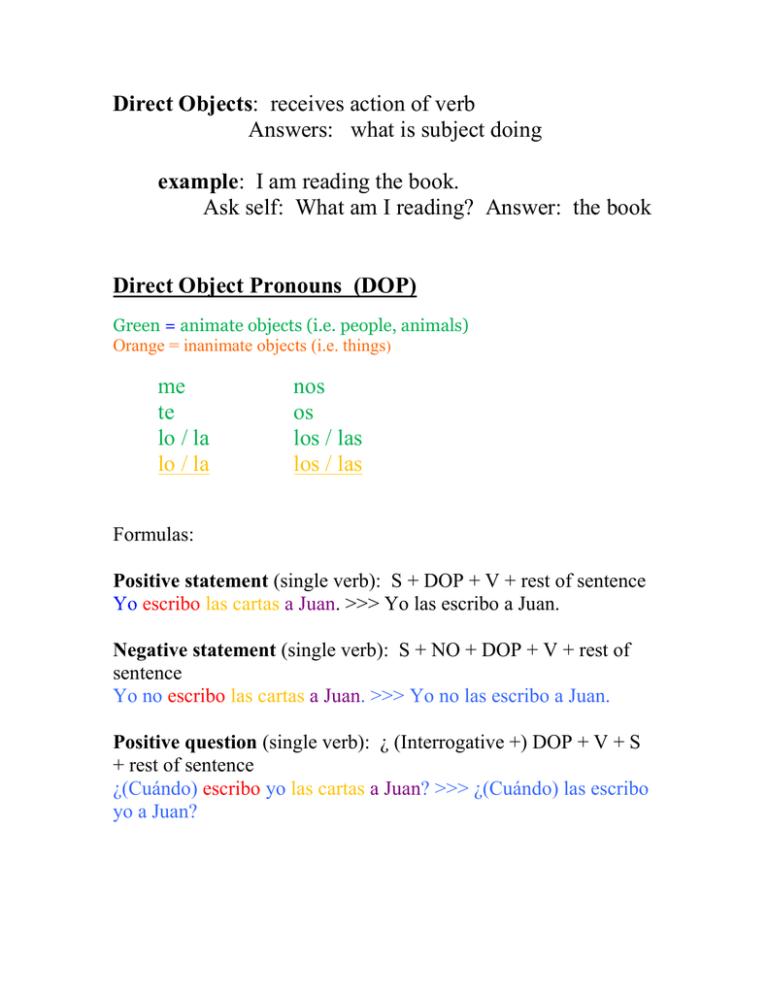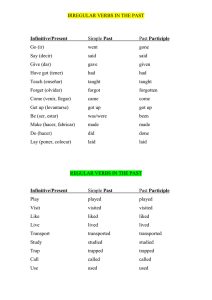Direct Objects: receives action of verb Answers: what is subject
Anuncio

Direct Objects: receives action of verb Answers: what is subject doing example: I am reading the book. Ask self: What am I reading? Answer: the book Direct Object Pronouns (DOP) Green = animate objects (i.e. people, animals) Orange = inanimate objects (i.e. things) me te lo / la lo / la nos os los / las los / las Formulas: Positive statement (single verb): S + DOP + V + rest of sentence Yo escribo las cartas a Juan. >>> Yo las escribo a Juan. Negative statement (single verb): S + NO + DOP + V + rest of sentence Yo no escribo las cartas a Juan. >>> Yo no las escribo a Juan. Positive question (single verb): ¿ (Interrogative +) DOP + V + S + rest of sentence ¿(Cuándo) escribo yo las cartas a Juan? >>> ¿(Cuándo) las escribo yo a Juan? Negative question (single verb): ¿No + DOP + V + S + rest of sentence? ¿No escribo yo las cartas a Juan? >>> ¿No las escribo yo a Juan? Positive statement (verb phrase): S + DOP + VP + rest of sentence or S + VP + DOP (one word attached to infinitive or participle) Yo quiero escribir las cartas a Juan. >>> Yo las quiero escribir a Juan. OR Yo quiero escribirlas a Juan. Negative statement (verb phrase): S + NO + DOP + VP + rest of sentence or S + NO + VP + DOP (one word attached to infinitive or participle) + rest of sentence Yo no quiero escribir las cartas a Juan. >>> Yo no las quiero escribir a Juan. OR Yo no quiero escribirlas a Juan. Positive Command: ¡Command form + DOP (all one word) + S! ¡Escríbe tú las cartas a Juan! >>> ¡Escríbelas tú a Juan! Negative Command: ¡No + DOP + command form +S! ¡No escribas tú las cartas a Juan! >>> ¡No las escribas tú a Juan! Indirect Objects: to whom or for whom something is done example: I am reading the book to Juan. Ask self: To Whom am I reading? Answer: Juan Indirect Object Pronouns (IOP) me te le le nos os les les Formulas: Positive statement (single verb): S + IOP + V + + DO + rest of sentence Yo escribo las cartas a Juan. >>> Yo le escribo las cartas a Juan. Negative statement (single verb): S + No + IOP + V + DO + rest of sentence Yo no escribo las cartas a Juan. >>> Yo no le escribo las cartas a Juan. Positive question (single verb): ¿ (Interrogative +) IOP + V + S + DO + rest of sentence ¿(Cuándo) escribo yo las cartas a Juan? >>> ¿(Cuándo) le escribo yo las cartas a Juan? Negative question (single verb): ¿No + IOP + V + S + DO + rest of sentence ¿No escribo yo las cartas a Juan? >>> ¿No le escribo yo las cartas a Juan? Positive statement (verb phrase): S + IOP + VP + DOP + rest of sentence or S + VP + IOP (one word attached to infinitive or participle) + DO + ROS Yo quiero escribir las cartas a Juan. >>> Yo le quiero escribir las cartas a Juan. OR Yo quiero escribirle las cartas a Juan. Negative statement (verb phrase): S + NO + IOP + VP + DO + rest of sentence or S + NO + VP + IOP (one word attached to infinitive or participle) + DO + rest of sentence Yo no quiero escribir las cartas a Juan. >>> Yo no le quiero escribir las cartas a Juan. OR Yo no quiero escribirle las cartas a Juan. Positive Command: ¡Command form + IOP (all one word) + S + DO + ROS! ¡Escríbe tú las cartas a Juan! >>> ¡Escríbele tú las cartas a Juan! Negative Command: ¡No + IOP + command form +S + DO + ROS! ¡No le escribas tú las cartas a Juan! >>> ¡No le escribas tú las cartas a Juan! Combining DOPs and IOPs When both the DOP and the IOP begin with “l”, change the IOP to “se”. Formulas: Positive statement (single verb): S + IOP + DOP + V + rest of sentence Yo escribo las cartas a Juan. >>> Yo le se las escribo a Juan. Negative statement (single verb): S + No + IOP + DOP + V + rest of sentence Yo no escribo las cartas a Juan. >>> Yo no le se las escribo a Juan. Positive question (single verb): ¿ (Interrogative +) IOP + DOP + V + S + rest of sentence ¿(Cuándo) escribo yo las cartas a Juan? >>> ¿(Cuándo) le se las escribo yo a Juan? Negative question (single verb): ¿No + IOP + DOP + V + S + rest of sentence ¿No escribo yo las cartas a Juan? >>> ¿No le se las escribo yo a Juan? Positive statement (verb phrase): S + IOP + DOP + VP + rest of sentence or S + VP + IOP + DOP (one word attached to infinitive or participle) + ROS Yo quiero escribir las cartas a Juan. >>> Yo le se las quiero escribir a Juan. OR Yo quiero escribírselas a Juan. Negative statement (verb phrase): S + NO + IOP + DOP + VP + rest of sentence or S + NO + VP + IOP + DOP (one word attached to infinitive or participle) + rest of sentence Yo no quiero escribir las cartas a Juan. >>> Yo no le se las quiero escribir a Juan. OR Yo no quiero escribírselas a Juan. Positive Command: ¡Command form + IOP + DOP(all one word) + S + ROS! ¡Escríbe tú las cartas a Juan! >>> ¡Escríbeselas tú a Juan! Negative Command: ¡No + IOP + DOP + command form +S + ROS! ¡No le escribas tú las cartas a Juan! >>> ¡No le se las escribas tú a Juan!
